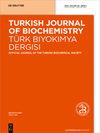Differentiation of hematopoietic stem cells isolated from peripheral blood to megakaryocyte
IF 0.7
4区 生物学
Q4 BIOCHEMISTRY & MOLECULAR BIOLOGY
Turkish Journal of Biochemistry-turk Biyokimya Dergisi
Pub Date : 2013-01-01
DOI:10.5505/TJB.2013.52714
引用次数: 0
Abstract
Objective: Thrombocytopenia remains a serious problem in patients treated with highdose chemotherapy and bone marrow transplantation. In recent years, infusion of ex vivo expanded megakaryocytes (Mk) progenitors into patients has been proposed as a strategy for shortening the time of platelet engraftment. The development of in vitro culture methods to obtain sufficient numbers of Mks from haematopoietic stem cells (HSC) is an important target in basic and clinical research projects. The aim of this study was to develop a two-step ex vivo expansion culture system of Mk progenitors from peripheral blood stem cells (PBSC). Methods: PBSC were harvested from three healthy adult donors. CD34+ cells were isolated and cultured in serum free media supplemented with thrombopoietin (TPO) (50 ng/ml), Interleukin 3 (IL-3) (20 ng/ml) and Interleukin 6 (IL-6) (20 ng/ml) for 12 days followed by an incubation with IL-6 (20 ng/ml) and TPO (50 ng/ml) for another 9 days. The differentiation of Mks was monitored by flow cytometry (% of CD34+/41+ cells). The morphology of the cells was studied by light, electron and fluorescence microscopy. Results: Morphological analysis of cells generated after 7 days of culture showed typical aspects of developing Mks. The percentage of CD41+ cells was higher than 70 on day 21. Conclusion: The results obtained in this study demonstrated that this two-step culture system is an effective method to obtain high rates of megakaryocytes. It is obvious that this promising method needs further development for clinical applications.外周血分离的造血干细胞向巨核细胞的分化
目的:血小板减少症仍然是高剂量化疗和骨髓移植患者的一个严重问题。近年来,体外扩增巨核细胞(Mk)祖细胞输注被认为是缩短血小板植入时间的一种策略。从造血干细胞(HSC)中获得足够数量的Mks的体外培养方法的发展是基础和临床研究项目的重要目标。本研究的目的是建立外周血干细胞(PBSC) Mk祖细胞的两步体外扩增培养系统。方法:从3名健康成人供体中采集PBSC。分离CD34+细胞,在添加血小板生成素(TPO) (50 ng/ml)、白细胞介素3 (IL-3) (20 ng/ml)和白细胞介素6 (IL-6) (20 ng/ml)的无血清培养基中培养12天,再与IL-6 (20 ng/ml)和TPO (50 ng/ml)孵育9天。流式细胞术检测Mks的分化情况(CD34+/41+细胞百分比)。光镜、电镜、荧光显微镜观察细胞形态。结果:培养7天后产生的细胞形态学分析显示出Mks发育的典型方面。第21天CD41+细胞百分比高于70。结论:两步培养法是获得巨核细胞率较高的有效方法。显然,这种有前途的方法需要进一步发展临床应用。
本文章由计算机程序翻译,如有差异,请以英文原文为准。
求助全文
约1分钟内获得全文
求助全文
来源期刊
CiteScore
1.20
自引率
0.00%
发文量
0
审稿时长
6-12 weeks
期刊介绍:
Turkish Journal of Biochemistry (TJB), official journal of Turkish Biochemical Society, is issued electronically every 2 months. The main aim of the journal is to support the research and publishing culture by ensuring that every published manuscript has an added value and thus providing international acceptance of the “readability” of the manuscripts published in the journal.

 求助内容:
求助内容: 应助结果提醒方式:
应助结果提醒方式:


